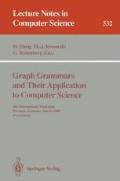Abstract
While in general the recognition problem for (hyper-)edge replacement grammars is NP-complete, there are polynomial algorithms for restricted graph classes. The degree of the corresponding polynomial depends on the size of the right hand sides of the grammar, and this size cannot be restricted without restricting the generative power.
In this paper we show that for the class of cyclically connected graphs the recognition problem for edge replacement grammars can be solved in cubic time, i.e. the degree of the polynomial does not depend on the size of the right hand sides of the grammar. For this result we give a suitable normal form for an edge replacement grammar. The algorithm uses the idea of the Cocke-Kasami-Younger algorithm and depends crucially on an algorithm of Hopcroft and Tarjan, which can be used to determine the form of a derivation tree for the given graph.
Preview
Unable to display preview. Download preview PDF.
References
M. Bauderon and B. Courcelle. Graph expressions and graph rewritings. Math. Systems Theory, 20:83–127, 1987.
F.J. Brandenburg. On polynomial time graph grammars. In R. Cori et al., editors, STACS '88, Proc. of the 5th Annual Symposium on Theor. Aspects of Comp. Sci., Bordeaux, Lect. Notes Comp. Sci. 294, pages 227–236. Springer, 1988.
V. Claus, H. Ehrig, and G. Rozenberg, editors. Graph-Grammars and Their Application to Computer Science and Biology, Lect. Notes Comp. Sci. 73. Springer, 1979.
B. Courcelle. An axiomatic definition of context-free rewriting and its application to NLC graph grammars. Theor. Comp. Sci., 55:141–181, 1987.
D. Coppersmith and S. Winograd. Matrix multiplication via arithmetic progressions. Proc. 19th ACM Symp. on Theory of Computing, New York City, pages 1–6, 1987.
H. Ehrig, M. Nagl, and G. Rozenberg, editors. Graph Grammars and Their Application to Computer Science, Lect. Notes Comp. Sci. 153. Springer, 1983.
H. Ehrig, M. Nagl, G. Rozenberg, and A. Rosenfeld, editors. Graph-Grammars and Their Application to Computer Science, Lect. Notes Comp. Sci. 291. Springer, 1987.
J. Engelfriet and G. Rozenberg. A comparison of boundary graph grammars and context-free hypergraph grammars. Inf. and Computation, 84:163–206, 1990.
P. C. Fischer, A. R. Meyer, and A. L. Rosenberg. Counter machines and counter languages. Math. Systems Theory, 2:265–283, 1968.
S. Ginsburg. The Mathematical Theory of Context-Free Languages. McGraw-Hill, New York, 1966.
A. Habel. Hyperedge replacement: Grammars and languages. Diss., FB Mathem. / Inform., Uni. Bremen, 1989.
A. Habel and H.-J. Kreowski. Characteristics of graph languages generated by edge replacement. Theor. Comp. Sci., 51:81–115, 1987.
A. Habel and H.-J. Kreowski. Some structural aspects of hypergraph languages generated by hyperedge replacement. In F.J. Brandenburg et al., editors, STACS '87, Proc. of the 4th Annual Symposium on Theor. Aspects of Comp. Sci., Passau, Lect. Notes Comp. Sci. 247, pages 207–219. Springer, 1987.
J. E. Hopcroft and R. E. Tarjan. Dividing a graph into triconnected components. SIAM J. Comp., 2:135–158, 1973.
J. E. Hopcroft and J. D. Ullman. Introduction to Automata Theory, Languages and Computation. Addison-Wesley, Reading, Mass., 1979.
H.-J. Kreowski. Rule trees represent derivations in edge replacement systems. In G. Rozenberg and A. Salomaa, editors, The Book of L, pages 217–232. Springer, Berlin, 1986.
C. Lautemann. Efficient algorithms on context-free languages. In T. Lepistö et al., editors, Automata, Languages and Programming Tampere, Lect. Notes Comp. Sci. 317, pages 362–378. Springer, 1988.
K.-J. Lange and E. Welzl. String grammars with disconnecting or a basic root of the difficulty in graph grammar parsing. Discrete Appl. Math., 16:17–30, 1987.
S. MacLane. A structural characterization of planar combinatorial graphs. Duke Math. J., 3:460–472, 1937.
G. Rozenberg and E. Welzl. Boundary nlc graph grammars — basic definitions, normal forms and complexity. Inf. and Control, 69:136–167, 1986.
W. Vogler. On hyperedge replacement and bnlc graph grammars. In M. Nagl, editor, Graph-Theoretic Concepts in Comp. Sci., Proc. 15th Int. Workshop WG '89, Castle Roduc, Lect. Notes Comp. Sci. 411, pages 78–93. Springer, 1990.
Author information
Authors and Affiliations
Editor information
Rights and permissions
Copyright information
© 1991 Springer-Verlag Berlin Heidelberg
About this paper
Cite this paper
Vogler, W. (1991). Recognizing edge replacement graph languages in cubic time. In: Ehrig, H., Kreowski, HJ., Rozenberg, G. (eds) Graph Grammars and Their Application to Computer Science. Graph Grammars 1990. Lecture Notes in Computer Science, vol 532. Springer, Berlin, Heidelberg. https://doi.org/10.1007/BFb0017421
Download citation
DOI: https://doi.org/10.1007/BFb0017421
Published:
Publisher Name: Springer, Berlin, Heidelberg
Print ISBN: 978-3-540-54478-4
Online ISBN: 978-3-540-38395-6
eBook Packages: Springer Book Archive

